Our Roots Are Still Alive - Chapter 18
Previous: Chapter 17
Table of Contents
Next: Conclusion
New Jersey Solidarity-Activists for the Liberation of Palestine Main Site
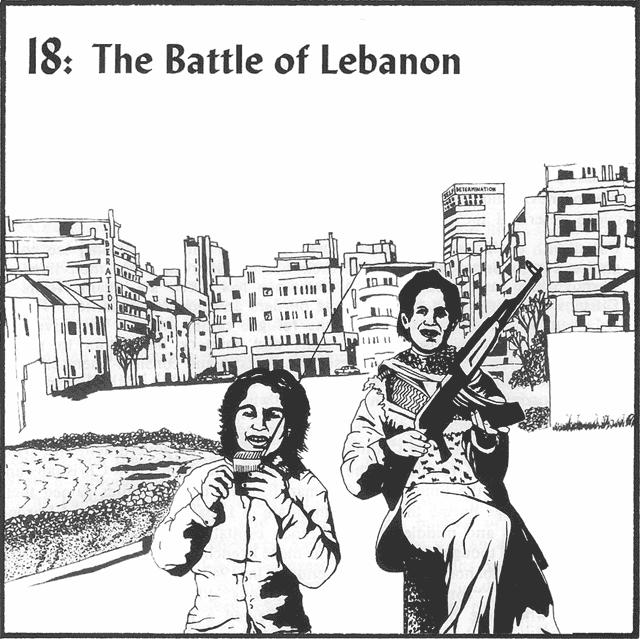
- We have survived hunger, thirst, and a total lack of medicines with a steadfastness which no one can paralyze or break. For we know that in defending our camp, we are defending our very existence - the life of our people, their will to exist, and their determination to struggle for their return to their homeland.
- Message from Tal al Zaatar
Palestinian fighters based in southern Lebanon had been staging raids into Israel since 1969. When Jordan expelled the fedayeen after Black September, Lebanon became the major base for the armed struggle against Israeli occupation. The Israelis dubbed the hilly border area of southern Lebanon "Fatahland" and launched hundreds of "punitive operations" against it in the early 1970s. A visiting journalist described the repeated bombings of one Lebanese village:
- Rashaya Fuqhar, once a prosperous little village of two thousand Christian Arabs, is now nearly a ghost town. Known for its simple but striking brown and tan pottery, its kilns are now cold. In the past year, five villagers have been killed and over thirty wounded by Israeli air and artillery bombardment. The pottery factory has been smashed by bombs. Scores of others have been damaged by shelling .... Only a hundred residents remain. A few of the villagers still farm, but most are afraid to because the fields are strafed.1
The Israelis thought their attacks would drive a wedge of hatred between the Lebanese and Palestinians. They were mistaken. The Lebanese peasants knew that Israel had designs on their land. Since the early days of the Zionist movement, its leaders had wanted to include southern Lebanon up to the Litani River inside the borders of a "Greater Israel." Rather than turn against the Palestinians, most Lebanese peasants demanded that the Lebanese army fight back against Israeli raids. The army never did. Only the fedayeen stood up to Israel. French journalist Eric Rouleau described the result:
- Faced with the Lebanese army's failure, [Lebanese and Palestinians] see no choice but to unite in defense of their homes, their children, their lives. Through the years, the collective resistance has taken an organic form. Citizens have organized to defend the borders and population centers. The fedayeen, whose duty is to protect the refugee camps and the exclusively Palestinian quarters, also furnish arms and military instructors to the Lebanese militia ... [B]oth Lebanese and Palestinians consider themselves part of the "community of misery" ... [T]hey live in hatred of the Lebanese state, the army, the Maronite middle class, who are perceived as enemies.2
The Maronite middle class - bankers, businessmen, nightclub owners and professionals of the Maronite Catholic sect - had run the government and army of Lebanon for years. Groomed by the French, who took their fellow Christians under "protection" in the time of the Ottoman Empire, the Maronites gained their position of privilege during the French mandate in Lebanon. They served Europe loyally as traders and middlemen for French capital. They considered Moslem Arabs inferior and thought of themselves as more French than Arab. France rewarded them when Lebanon became independent in 1943 by setting up a political system based on "confessionalism" or religious differences. The Maronite Christians, who were half the population, received a majority of seats in the parliament and control of the army. The remaining seats and other positions in the government went to other religious sects, primarily Moslems, who made up the other half of the population.
A Society Divided
The creation of Israel in 1948 had a profound effect on Lebanon. When the Arab states organized the trade boycott against Israel, Lebanon suddenly received Palestine's historic shipping and banking business. It also gained more than a hundred thousand Palestinian refugees. The Maronites wanted the new business but despised the new immigrants, who threatened to upset the delicate balance between Christian and Moslem. Throughout the 1950s and 1960s Beirut's skyline became dominated by American business. Chase Manhattan, Bank of America, Holiday Inn, the oil companies and other corporations set up shop in this "neutral" financial oasis on the border of the Arab-Israeli conflict. The Maronites prospered in their role as middlemen. The government looked after their interests and kept the army out of the conflict with Israel.
Some of the first Palestinians to flee the Israeli attacks in 1948 settled in Beirut. Soon Palestinian refugee camps and slums ringed the city in what became known as the "belt of misery." Starting in the late 1960s, thousands of Lebanese poor joined them. Refugees from Israeli bombing in the south, farmers who had lost their land and unemployed workers from neglected and declining industries crowded into Beirut in search of work. There were few jobs for them except as maids, janitors and shoeshine boys. The government had done little to create jobs in the city, just as it had built few new roads or irrigation projects in the countryside to help the largely Moslem peasants. By 1975, six hundred thousand people were trying to survive in the belt of misery. The French journalist Rouleau described one slum:
- A nauseous stench rises from the numerous garbage heaps lining the narrow alley. Children with fly-covered faces wade in the muddy puddles .... [A] hut of rusted sheet-metal houses children, parents and grandparents. The squatters in this shanty town in the heart of Beirut are painfully aware of their abandonment. They have but to raise their eyes to contemplate the proud buildings with flower-painted verandas where wealthy Christians live.3
The belt of misery was quickly becoming a "belt of anger" directed at the Lebanese rich and their self-serving control of the Lebanese government. That anger was expressed in waves of strikes and demonstrations by Lebanese workers and students that began in the early 1970s and grew stronger by the year. They protested the failure of the Lebanese government to serve all the people of Lebanon, and they demanded an end to the privileges of the Maronites and the Western corporations.
The Palestinians acted as a sort of shield to protect the growing Lebanese movement from the army and began training militias of the progressive organizations to defend themselves. Such self-defense was an absolute necessity. For several years the right-wing businessmen and politicians had been organizing large private militias to use against the poor, in case the army did not prove strong enough. The journalist Rouleau described the training of one right-wing militia by a French mercenary who was so used to fighting guerrillas in Africa that he ordered his men into battle with the cry, "Let's go men, the niggers are over here."4
The growth of the progressive movement in Lebanon posed a serious threat to the power and privilege of the reactionaries who ruled Lebanon. By 1975, with the American and Arab drive for a general peace settlement in the Middle East, the Lebanese government and its supporters could count on U.S. backing for an offensive against the Palestinians. In January 1975, Pierre Gemayel, head of the right-wing Phalangists, demanded that the Lebanese army take action against the Palestinians in the south and in the cities. The Cedars Defense Front, called the "Lebanese Ku Klux Klan" by the left, covered Beirut walls with its racist slogans: "No to the Palestinian Resistance! No to the Arabs! No to foreigners! No to Communism!"5
In February fishermen in the port city of Sidon went out on strike. They had learned that the government had granted all fishing rights off Sidon to a company controlled by Christian rightists who reportedly had connections to the CIA. The government ordered the army into Sidon, where soldiers killed eleven strikers. Palestinians joined Lebanese in building barricades against the army and in blockading Beirut harbor in solidarity with the workers of Sidon. That same week, Gemayel's right-wing Phalangists marched through Beirut chanting their praise of the army's actions and calling for the expulsion of the Palestinians from Lebanon.
After the Sidon demonstrations a slogan appeared all over the walls of Beirut: "Gemayel = Rabin = CIA." The Palestinians and Lebanese progressives knew that the Phalangists were acting in the interests of U.S. imperialism and the Zionists. The United States and Israel understood this too. As the conflicts between the Phalangists and the Lebanese-Palestinian alliance grew sharper, the United States sent G. McMurtrie Godley as its new ambassador to Lebanon. He was notorious for his CIA connections, having directed covert operations in Zaire, Cambodia and Laos. Godley's mission was to work with Lebanon's upper-class and right-wing militias to protect U.S. corporate interests in Lebanon.
Israel had been secretly supplying weapons and military training to the Lebanese rightists for several years. Israel, like the United States, wanted to see the Palestinians defeated in Lebanon - their last open stronghold. Israeli Prime Minister Yitzhak Rabin was frank about his strategy. When a reporter asked him why Israel failed to retaliate for a Fatah attack on a Tel Aviv hotel in April, Rabin replied, "We have chosen not to reply to this operation because we are planning on and waiting for a confessional [religious] war in Lebanon which would have the same result."6
Civil War: The Rich Against the Poor
The "confessional war" broke out a few days later when the Phalangists fired on a busload of Palestinians who were returning from a demonstration. Twenty-six Palestinians were killed. Fighting between Phalangists and Palestinians escalated. Soon a full-scale civil war between the Lebanese rightists and the newly formed Front of Progressive and Patriotic Parties and Forces engulfed Lebanon.
Although the Western media ignored the underlying class conflict and tried to portray the fighting as a "religious war," it clearly was not. The Lebanese Front, which included Moslems and Christians in its ranks, fought for an end to a government organized along religious lines. It wanted to create a democratic and secular state in Lebanon. It also demanded reforms in the army, better social services for the poor, more jobs and a living wage for all work. It firmly supported the Palestinians' presence in Lebanon. These demands horrified the rightists and their international backers. Besides the CIA, one of the major suppliers of arms to the largely Christian right wing was Saudi Arabia, the bastion of Moslem orthodoxy, which sent $200 million worth of aid. The Saudis understood that the war in Lebanon was not between religions, but between classes.
The fighting raged throughout 1975. Many thousands died from malaria and TB epidemics as well as from bullet wounds. The year ended without decisive victory for either side. Beirut was a burned-out city, its port and office buildings destroyed. The Lebanese Front and the Palestinians controlled western Beirut, and the rightists had the eastern half of the city. The Palestinian camps in the belt of misery blocked the right-wing forces from joining east Beirut to their mountain strongholds beyond the camps. Each side held parts of the rest of the country.
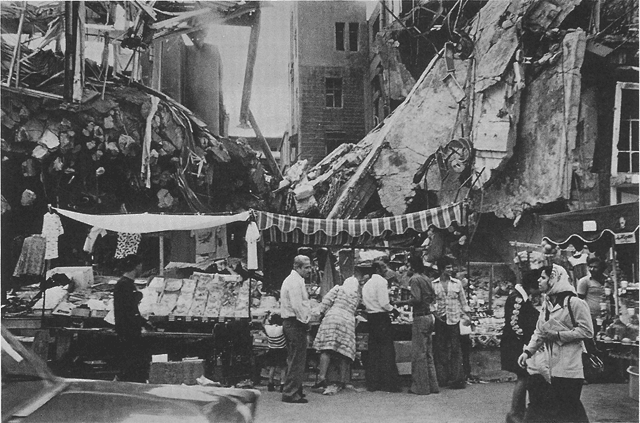 Destruction from rightist artillery in downtown Beirut
Destruction from rightist artillery in downtown Beirut
In January of 1976 the rightists launched a new offensive. They blockaded the Palestinian camp of Tal al Zaatar and overran the smaller camp of Dabaye, home of two hundred Christian Palestinians. Up to this point, the Palestinians had not thrown their full weight into the fighting. Now they did. By the spring, the forces of the Lebanese Front and the Palestinians controlled 80 percent of the country.
The prospect of a victory for the Palestinians and their Lebanese allies spurred Israel and the United States to more direct action. In March of 1976, Israeli ships began a blockade of the leftist-controlled ports of Sidon and Tyre, stopping ships bound for Lebanon with arms and supplies. Israel shipped massive amounts of its own U.S.-supplied ammunition and supplies, including heavy weapons like rockets and tanks, to the rightists.7 The United States sent the helicopter carrier Guadalcanal, six other ships and seventeen hundred Marines to cruise off the Lebanese coast in April. They served as a grim reminder of the American Marine landing in Lebanon in 1958 on the side of the rightist government.
But none of these moves stopped the Palestinians and Lebanese. Both Israel and the United States were alarmed, and Israel threatened to intervene directly. However, neither Israel nor the United States could invade Lebanon without risking a wider war and a massive international outcry. Only another Arab country could get away with sending its troops into Lebanon. Hafez Assad, the President of Syria, was ready to do just that.
Assad had feared from the beginning of the war that Israel was going to use the threat of a Palestinian-Lebanese nationalist victory as an excuse to invade Lebanon and Syria. Assad did not want to see a strong and independent Palestinian movement or a radical Lebanon on his western border. He had never supported the existence of an independent Palestinian movement outside the control of Arab governments. An independent PLO might block the chances of a peace settlement with Israel and the return of Syria's occupied Golan Heights. As commander of the Syrian Air Force in 1970, he had refused to give air cover to the Syrian tank column moving into Jordan to support the Palestinians during Black September.
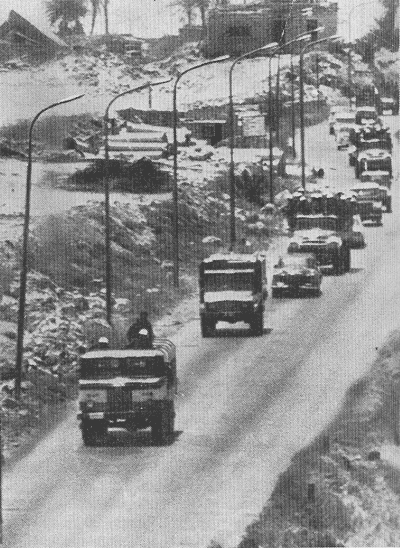
Syrian troops invade Lebanon, May 1976.
A power struggle had followed, in which Assad staged a successful coup against his leftist opponents in Syria who strongly supported the Palestinians. He jailed his opponents and purged Saiqa, the Palestinian guerrilla organization sponsored by Syria, of its most independent members. Like Sadat of Egypt, once he was in power, Assad reversed many of the progressive economic policies and social reforms of his predecessors. In Lebanon, he wanted to see a "moderate" government and a humbled Palestinian movement that he could control.
When the Palestinian-Lebanese offensive was on the brink of victory in the spring of 1976, Assad decided to send his army into Lebanon - once he had American permission. In March King Hussein of Jordan visited Washington, D.C., and told Ford and Kissinger that Assad was ready to intervene on the side of the rightists in Lebanon. This solved the American dilemma, and the United States agreed to restrain Israel from any counterattack. On May 31, tens of thousands of Syrian troops and hundreds of tanks crossed the border into Lebanon. The Syrian government, which had once been the consistent supporter of the Palestinian people, was now the powerful ally of the Lebanese rightists.
Assad expected an easy advance. But at Sidon, Aley and Sofar, united Lebanese and Palestinian troops stopped the Syrian tanks and drove back the infantry. The battles were fierce and bloody. One captured Syrian soldier who had fought against Israel in the October War said:
- Even on the Golan, I never experienced such fighting. Here, in Sidon, it was street fighting, very difficult. The war on the Golan was very much easier.8
Assad had not counted on such determined resistance. Palestinians encouraged the Syrian soldiers to mutiny. In the next months, most members of Saiqa - the Syrian-supported Palestinian guerrilla group - defected to other organizations in the PLO. With his troops stalled and Saiqa weakened, Assad sanctioned increasingly brutal attacks on Palestinian camps by the rightists. The Syrians themselves began shelling camps in June.
Tal al Zaatar Fought for the Revolution
Finally Syria approved an all-out rightist assault on the refugee camp of Tal al Zaatar. Located in the rightist section of Beirut, Tal al Zaatar had withstood months of attacks and a blockade of food and supplies. The Syrians and rightists thought the destruction of the camp would weaken and demoralize the Palestinian and Lebanese movements. The rightists laid siege to the camp on June 21, 1976. During the next fifty-three days, they poured thousands of artillery shells and rockets into Tal al Zaatar. They mounted over seventy attacks on the camp. They blocked all food and medical supplies from going in and refused to allow the Red Cross to carry away the wounded. Yet the people of Tal al Zaatar stood firm.
On July 13, the inhabitants of Tal al Zaatar smuggled out of the camp an open letter "to the people of the world." It was sent to a meeting in Cairo of Arab heads of state. In it, they described their situation, criticized Syria's role and asked for medical supplies:
- [W]e speak to you now ... not to obtain sympathy but from a position of heroic steadfastness which this camp has maintained for every moment of this long siege ....
Our camp - which is now inhabited by around thirty thousand men, women, children and old people, about 40 percent of whom are poor Lebanese and the rest Palestinians - is today a scene of utter destruction. There is no water except the very little we can carry from the wells amidst the danger of shelling and death; no food except what we have been able to salvage from the wreckage of our homes; no electricity whatsoever, no medicines and no medical treatment ....
Syrian weapons are being used - most unfortunately - against our camp, while the rulers of Damascus continue to repeat that they are here in Lebanon in order to defend our camp. This is a murderous lie, a lie which pains us more than anyone else .... But we wish to inform you that we will fight in defense of this camp with our bare hands if all our ammunition is spent and all our weapons are gone, and that we will tighten our belts so that hunger will not kill us. For we have taken a decision not to surrender and we shall not surrender ....
We have survived hunger, thirst and a total lack of medicines, with a potential for steadfastness which no one can paralyze or break. For we know that in defending our camp, we are in fact defending our very existence, the life of our people, their will to exist, and their determination to struggle for their return to their homeland.9
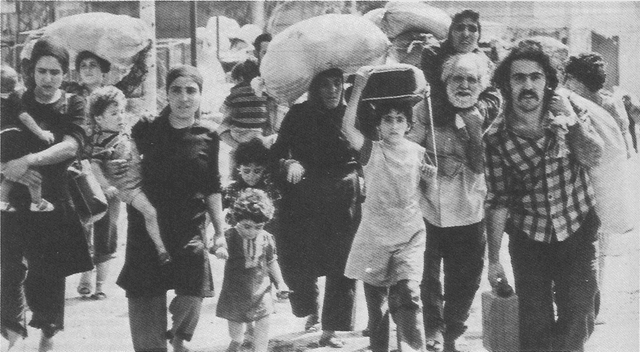 Refugees flee Tal al Zaatar.
Refugees flee Tal al Zaatar.
The Arab states did not help the people of Tal al Zaatar, nor did they restrain Syria. Iraq and Algeria condemned the Syrian invasion, but Saudi Arabia sent more aid to the Assad government. International help for the Palestinians and Lebanese was blocked at the ports. The Soviet Union condemned the invasion, but took no steps to break the naval blockade or to pressure Syria, which it supplied with arms. Most arms and food for the Palestinian and Lebanese fighters came from PLO stockpiles in the south or were smuggled into Lebanon on small ships from Cyprus. Although only small amounts of it got into Lebanon, the aid that meant the most to Palestinians came from their brothers and sisters under Israeli occupation. West Bank Palestinians had demonstrated in June against the Syrian intervention in Lebanon. In July they managed to send several planeloads of medical supplies to Lebanon. But none of these desperately needed supplies could get through the blockade of Tal al Zaatar.
On August 13, after fifty-three days of unrelenting siege, the defenders of the camp let down their guard as the first Red Cross vehicles approached Tal al Zaatar with the permission of the rightists. The people of the camp believed that a final agreement between the Arab League and the International Red Cross to evacuate the camp had been reached. As the inhabitants of the camp began to leave their shelters, they saw they had been betrayed: behind the Red Cross vehicles were the rightist troops! As soldiers overran the camp, they unleashed a bloody massacre, gunning down defenseless civilians, including medical personnel. The rightists deliberately killed every Palestinian male between the ages of fourteen and forty. Before the camp was totally overwhelmed by the attackers, thousands of people were forced to flee; over two thousand people were killed. The rightists razed Tal al Zaatar to the ground.
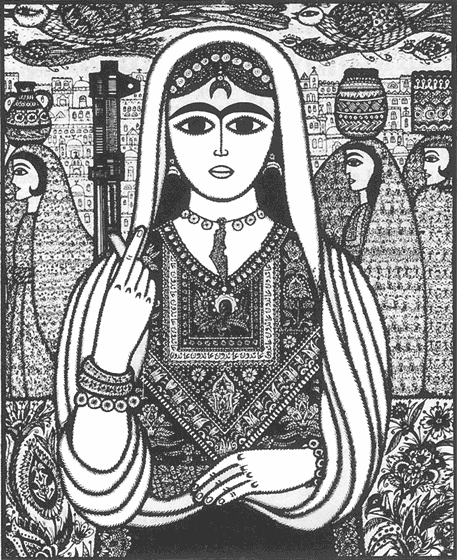
Rightists, Syrians and the American press all proclaimed that the fall of the camp signaled the beginning of the end for the Palestinians. But to every Palestinian and Lebanese fighting against the Syrian occupation and the rightist forces, Tal al Zaatar stood for something very different. One Fatah leader said, "It has become a torch for all those struggling for freedom in the Arab world."10 The people of Tal al Zaatar, like Palestinians and Lebanese in the rest of the country, were determined to fight to the end. Fatah leader Abu Eyad explained why:
- We have nothing left to lose. We have burned our ships behind us. There is nothing but the sea in back of us. We have no choice. We cannot retreat, but they cannot exterminate us.11
The Syrian army encountered this grim determination wherever it fought. The Syrians were failing in their offensive to capture Sidon and Western Beirut. The war was now costing Syria a million dollars a day. Israel was taking advantage of the drawn-out war to encroach on southern Lebanon. And the PLO refused to replace Arafat with a pro-Syrian leadership as Assad demanded.
Finally, the Arab states decided they had to intervene. At the Riyadh Conference called by Saudi Arabia, Yasser Arafat and Hafez Assad sat down with delegates from the other countries in the Arab League to work out an agreement. The resulting "peace plan" gave the beleaguered Palestinians and their Lebanese allies a breathing spell. It reaffirmed the 1969 Cairo Accords which gave the Palestinians freedom of movement and their right to bear arms in Lebanon. Syria, on the other hand, expanded its occupation of Lebanon, under the cover of an "Arab peacekeeping force" which was paid for by the Arab states. The uneasy "peace" that settled on Lebanon brought Syrian troops into western Beirut. They oversaw the installation of a pro-Syrian Lebanese government led by Elias Sarkis. This government began censoring all pro-Palestinian and anti-government publications and closed down guerrilla offices.
Despite this repression, Lebanon had not become the graveyard of the Palestinian movement. Although twenty thousand Palestinians had died in the fighting, the PLO remained intact and independent of Syrian control. Palestinians were in control of the camps and held on to their heavy weapons. With the major fighting over, the PLO was able to hold the first meeting in three years of the Palestine National Council in Cairo. The Council reaffirmed the unity of the Palestinian and Lebanese peoples. Despite strong pressure from the Arab governments to change its position of non-recognition of Israel, the Council stated once again its opposition to the Zionist state and its commitment to building a democratic secular state in all of Palestine.
In the meantime, the Palestinians and Lebanese went about the difficult task of healing the many wounds of war and preparing for the likely battles ahead. A poster tacked on a wall in Damour, the village where the inhabitants of Tal al Zaatar had resettled, expressed the spirit in which the Palestinians and their allies would move forward. It read simply: "Tal al Zaatar is in our hearts until victory."
Footnotes
- Judith Coburn, "Israel's Ugly Little War," New Times, 7 March 1975.
- Eric Rouleau, "Civil War in Lebanon," Le Monde (Paris), 20-25 September 1975, reprinted in translation in SWASIA, Vol. 2, no. 41 (17 October 1975), pp. 5-6.
- Ibid., p. 4.
- Ibid., p. 2.
- Ibid.
- Al-Sha'ab, 12 April 1975, cited in DFLP Reports (Spring 1975), pp. 3-4.
- Time, 13 September 1976, cited in "Why Syria Invaded Lebanon," MERIP no. 51, p. 5.
- Le Monde, 15 June 1976, cited in MERIP no. 51, p. 4.
- Tal al Zaatar: The Fight Against Fascism (Washington, D.C.: 1977), p. 7.
- SWASIA, vol. 3, no. 32 (13 August 1976), p. 7.
- San Francisco Examiner, This World, 25 July 1976.